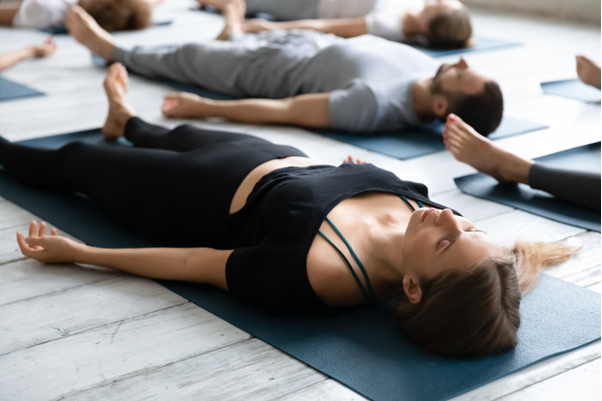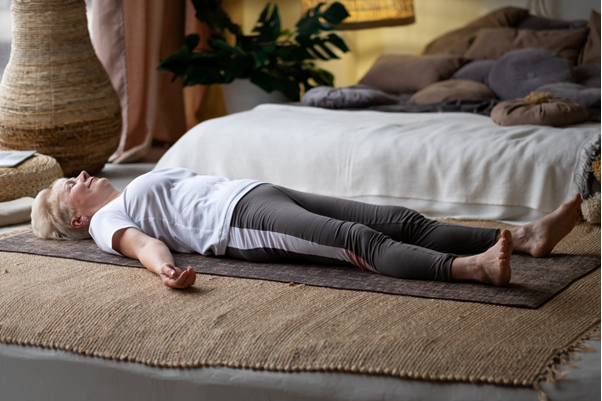
Anxiety, Sleep, and Inner Calm: The Benefits of Yoga Nidra Meditations
January 20, 2024
How have you been sleeping lately? Over the holiday season, most of us lose a bit of sleep whether it’s due to attending parties, stressing over presents, or making arrangements for family visits. With 2024 now fully underway, it’s time to get (back) on track and create a better sleep routine. Yoga Nidra meditations can help you establish a routine that supports restful sleep, limits feelings of anxiety, and creates a sense of inner calm.

Why Sleep Matters So Much
It’s hard to overestimate the importance of a good night’s sleep. If you’re not convinced, just take a look at statistics published by the Sleep Foundation. According to those figures, one in three adults in the U.S. are not getting enough sleep. Experts believe that insufficient sleep costs our economy more than $400 billion every year. Plus, sleeping whilst drowsy leads to more than 6,000 fatal car crashes every year.
Sleep has been linked closely to performance at work or in school. And even without scientific evidence, most of us will remember a time when we snapped at a friend or family member for no reason – except tiredness. Put simply, lack of sleep affects our physical and mental health.
How Yoga Nidra Can Improve Sleep Quality
In previous blog posts, we have looked separately at Yoga Nidra and at practicing yoga to support restful sleep. Here, we’d like to go a little more into detail about the combination of the two.
Yoga Nidra is also known as yogic sleep and is commonly considered to be one of the most powerful yet highly accessible meditation techniques. It’s also an ideal practice to help you relax deeply and drift off into restful sleep as opposed to suffering from disrupted, fitful nights or not getting any sleep at all.
If you have been to yoga classes, chances are you have already experienced some of the benefits of Yoga Nidra. Many of our classes at Uptown Yoga end with a period of deep relaxation lying in savasana at the end of the class. As you’re lying on your back listening to your instructor’s voice guiding you, you’re practicing Yoga Nidra.

Now imagine changing location to your bed and listening to a recorded sleep meditation as you drift off to sleep. This may not be the most conventional way to practice, but it’s certainly one of the simplest and most powerful ways of incorporating Yoga Nidra into your daily routine. It also limits the potential for excuses.
Using Yoga Nidra to Create a Sense of Inner Calm and Lower Anxiety
Not everyone uses Yoga Nidra to promote better sleep. The same practice can help you lower or limit your anxiety and establish a sense of inner calm you wouldn’t otherwise have had.
Yoga Nidra creates this sense of calm through the body scan and breath awareness stages. Both are calming the nervous system, thus reducing your overall stress levels and promoting better physical and mental health.
Step-by-step Guide to Yoga Nidra
Getting ready to practice Yoga Nidra doesn’t need to be difficult, but it helps if you spend a little time finding a yoga meditation app or recording you like. Once you found one or two options as well as a calm space where you won’t be disrupted, follow these steps:
- Start by lying on your back: stretch your arms out by your sides and extend your body as far as you can. Place your head so that you feel comfortable.
- Close your eyes: make sure your eyelids are relaxed and avoid squeezing your eyes shut.
- Breathe deeply: place one of your hands on your chest and the other one on your belly. Take a couple of big, deep breaths and really focus on your exhalation. Inhale through your nose and exhale through your mouth, imagining how you’re letting go of your day.
- Listen: if you haven’t already, start your recorded guide now and follow the instructions. You’ll be asked to visualize and focus on one body part at a time. Do your best to stay with the voice that is guiding you and avoid becoming distracted.
- Repeat: your recording will take you through step four for every single body part. Follow the voice. Once you have completed this step for every body part, you should feel relaxed and free of tension.
- Focus on your entire body: visualize your body as a whole.
- Return to consciousness: gently start bringing movement back into your body. Move your fingers and your toes, take a deeper breath, and open your eyes slowly.
- Sit up: slowly return to a sitting position. Don’t rush this transition or try to move aggressively. Find a comfortable seated position and take a few breaths here before fully returning to reality. Many people like to perform a few gentle asanas at this stage, too.
Who Can Practice Yoga Nidra and Where
Yoga Nidra is for anyone. There are no age or other restrictions, and you don’t need to be an accomplished practitioner of yoga in other areas to benefit from Yoga Nidra. With that said, Yoga Nidra offers an excellent transition from asanas to your meditation practice, and there are many other ways of incorporating this practice into your existing one.
Getting Started with Yoga Nidra at Uptown Yoga
Still feeling a bit daunted by giving Yoga Nidra a go without instructor support? No problem. At Uptown Yoga, many of our classes end in savasana with a Yoga Nidra practice that eases you into this type of relaxation. Why not try a Flow & Meditation class to experience the benefits of yoga asanas and yogic sleep?
If you’d like to know more about Yoga Nidra, don’t hesitate to approach your instructor with any questions you may have. We also offer special in-depth Yoga Nidra workshops several times a year. Those workshops offer excellent opportunities to advance your personal practice in a friendly and supportive environment. Contact us to find out more.




